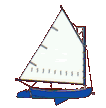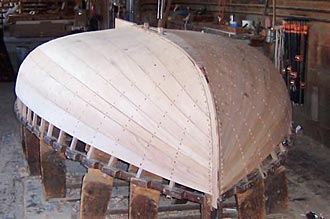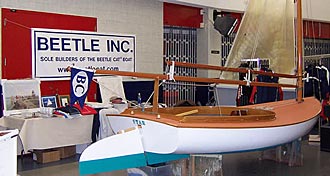Beetle Cat Construction & Care
Construction
In the tradition begun by the Beetle family in 1921, continued by Concordia Company, and today carried on by Beetle Inc, the Beetle Cat is constructed of the finest available materials by a group of skilled workers.
The keel and stem are constructed from air-dried white oak. The steam-bent frames are also of white oak, but cut from the butt of the tree to insure strength and fair bending. Hull planking is white cedar, properly air-dried. All fasteners are silicon bronze screws. Special care is given to the jointing and planking. All loose knots are reamed and plugged. Before plugs are driven they are dipped in glue to insure holding power. Each boat is caulked, faired, and sanded by hand. After each boat comes off the mould, it is given a coat of primer inside and out.
The deck beams are of clear pine sawn to the proper crown. Decking is of cedar, same as the hull. The mast step is of oak and is bridged over the stem and keel and through-bolted through each giving added support to stem and keel. The mast partner is also of oak. Added support is given by using a 2 x 3 strong back which runs fore and aft. It runs along the top of the centerboard box and is fastened to an extra heavy deck beam that helps support the mast partner. The deck beams rest on top of the strong back and are fastened to the sheer clamps. This construction gives a solid deck to walk or jump on. The one-half inch cedar decking is fastened to the deck beams and the top of the sheer plank. It too is plugged, faired, sanded, and then covered with No. 8 canvas duck. The canvas is not set in paint or other bedding as it would be damaged by the shrinking and swelling of the deck planks. Instead, the canvas is given a penetrating primer coat and another top coat.
Coamings are of clear, book-matched oak, steam-bent into place. They are scraped, sanded and varnished. The half?round rub rail is of the same and varnished. Spars are made of air-dried, straight-grain Douglas Fir. Gaff jaws of good dry oak. The mast is tennoned and bears on top of the mast step, preventing the mast from bearing on the stem / keel joint.
The stem is now laminated, producing a much more fair and exact shape (originally it was steam bent). Limber holes of good space have been allowed on all frames. A special mold has been built to insure fair lines and exact dimensions on every boat. Stem to keel fastenings have been bolted and nailed. Centerboard box sides and transoms use a splined glue-joint to ensure tightness. Full length floor boards are now removable for improved maintenance.
Today's Beetle Cat is of the highest quality, continuing the tradition of New England craftsmanship. The New England Beetle Cat Boat Association hopes you enjoy sailing your craft as generations have before you.
Care of a Beetle Cat
Storage
Storage under cover in an unheated garage, barn, or shed, with the boat right-side-up is best. Put two blocks under the keel, one eighteen inches forward of the centerboard slot and the other about eighteen inches forward of the stern along the skeg. To keep the boat upright (level side-to-side), put a chock under each side of the boat at the widest part of the boat and touching on the turn of the bilge.
If the boat must be left outside, keep it in the shade and avoid putting it on blacktop. Cover with a "breathable" tarpaulin or a simple roof. Do not allow the cover to lay directly anywhere on the canvas deck.
A Beetle Cat may be stored on a trailer provided the trailer properly supports the hull.
The older, non-plywood centerboards will stay straighter if left in position in the boat for the winter. Plywood centerboards and rudders should be stored in a standing position so the air reaches them from each side.
Spars should be placed on racks or blocking on the floor so as to be supported in two or three places. It is best if the sun does not beat directly on them.
Spring Commissioning
General
Your work place should be out of the weather and out of direct sunlight. Direct sunlight will open the seams very quickly. Some owners prefer to roll the boat over for hull work, but this is not necessary. With a narrow sawhorse located about eighteen inches forward of the centerboard slot and a wider sawhorse (at least five feet) located about two feet forward of the stern along the skeg, the boat can be rocked back and forth to allow all surfaces to be easily sanded and painted. If the sawhorses are 24" high, the boat should tip far enough to allow the board to be removed. If you need to get inside the boat, be sure it is extremely stable and secure.
Topsides
A good sanding is needed for good adhesion and smooth finish. Use 120, 150, or 180 grit sandpaper, depending on condition. Bulging putty or seam compound may be sanded off using 100 grit sandpaper over a block. If seems need any putty, use one made specifically for seams (stays soft). If seams are open due to drying out, minimal seam compound should be used since it will squeeze out when swelling occurs. A well maintained topside may require only one coat of marine enamel. Spots of bare wood may be "spot primed" with flat primer before finish coating. Depending on the starting conditions nd finish desired, a full coat of primer and / or a second coat of marine enamel may be needed. A thorough vacuuming and tack rag treatment between coats will provides the most blemish-free finish. A standard oil-base marine enamel is suggested. Polyurethanes and two-part paints are not recommended.
Bottom
Preparation is the same as for topsides except that coarser sandpaper mat be used. Bottom paint is its own primer. If you remove the centerboard, you may paint the whole board and also up inside the centerboard box.If you do, paint at least 8 inches up inside using a rag on a stick or a special 1" diameter roller (available at specialty paint stores).
Deck
It is not necessary to paint the deck every year. If you do paint, clean and sand lightly with 180 grit sandpaper and apply one coat of marine enamel, perhaps thinned a little. As with the topsides, a standard oil-base marine enamel is suggested. As the paint begins to build up over the years, a little 'non-skid compound' added to the paint will provide better footing on the deck.
Cockpit
It is not necessary to paint the cockpit every year. If you do, scrape away any loose paint and give a good hard sanding with 100 or 120 grit sandpaper. Spot prime any bare spots. When dry, apply one coat of marine enamel, perhaps thinned a little. Heavy buildup of paint may lead to peeling and blistering.
Bilge
It is good practice to clean out the bilge every year. A light scraping and thorough vacuuming will do the job. Some owners paint the bilge every few years. If you paint, scrape and sand thoroughly, vacuum, and paint one coat of cockpit or special bilge paint, perhaps thinned a little.
Briqhtwork and Spars
An extremely good sanding with 180 or 220 grit sandpaper is necessary to get the top surface clean and smooth. Be sure every surface is scratched. Any worn or peeling spots should be sanded to bare wood and primed with a 50/50 mixture of turpentine and spar varnish. A true 'spar varnish' should be used with polyurethanes and two-part finishes avoided. A thorough vacuuming and tack rag treatment before varnishing will provide the most blemish-free finish.
Rigging
Running rigging should be checked each Spring and replaced if worn or frayed. The following dimension may be helpful:
Throat 40 Feet
Peak 46 Feet
Peak (2 Block Rig) 62 Feet
Main Sheet 46 Feet
Gaff Bridle 42 Inches



